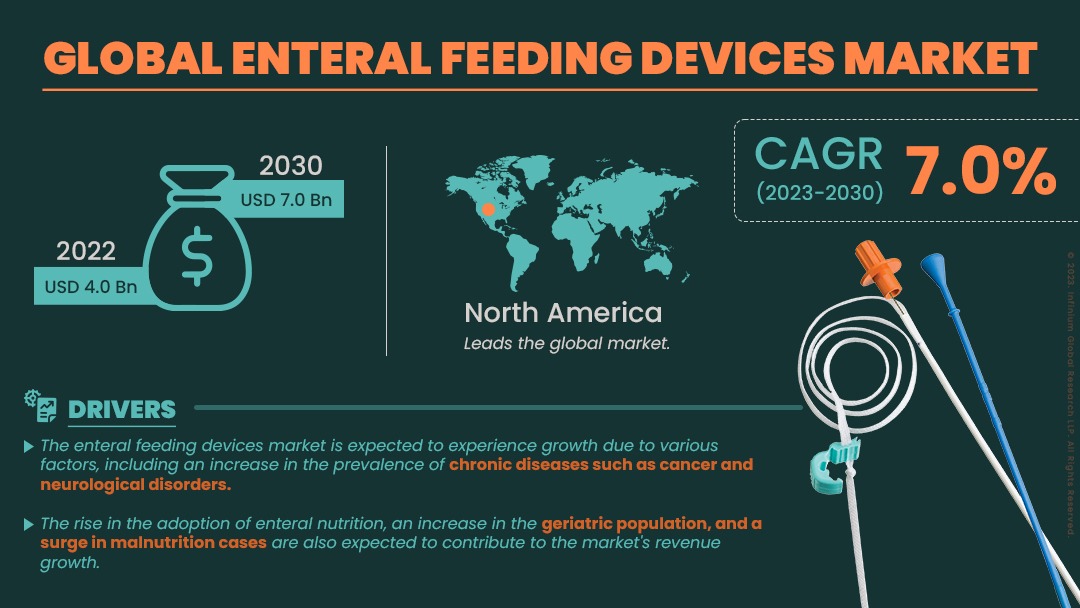Enteral Feeding Devices Market (Product - Giving Set, Feeding Pump, Percutaneous Endoscopic Gastrostomy Device, Low Profile Gastrostomy Device, Nasogastric Tube, and Gastrostomy Tube; Age Group - Pediatrics, and Adults; Application - Oncology, Critical Care, Diabetes, Gastroenterology, and Others; End User - Hospitals, Ambulatory Care Services, and Home Care): Global Industry Analysis, Trends, Size, Share and Forecasts to 2030
A recent report published by Infinium Global Research on enteral feeding devices market provides in-depth analysis of segments and sub-segments in the global as well as regional enteral feeding devices market. The study also highlights the impact of drivers, restraints, and macro indicators on the global and regional enteral feeding devices market over the short term as well as long term. The report is a comprehensive presentation of trends, forecast and dollar values of global enteral feeding devices market.
Market Insight:
Enteral feeding devices are medical devices that are utilized to provide nutrition to individuals who cannot obtain it through oral means, are at risk of unsafe swallowing, or require additional nutritional support. This method involves the ingestion of food through the gastrointestinal tract, which includes the mouth, esophagus, stomach, and intestines. The primary function of these devices is to administer medications and nutrition to patients with chronic conditions like malnutrition, gastrointestinal disorders, and cancer. Tube feeding allows them to receive the necessary nutrients and maintain the proper functioning of their GI tract. Enteral feeding can either be the primary source of caloric intake or serve as a supplement. These devices are typically used in medical settings such as operation theaters, intensive care units, and critical care units. However, they are also used in home care for severely ill patients.
The enteral feeding devices market is expected to experience growth due to various factors, including an increase in the prevalence of chronic diseases such as cancer and neurological disorders. The rise in the adoption of enteral nutrition, an increase in the geriatric population, and a surge in malnutrition cases are also expected to contribute to the market's revenue growth. However, the market growth may be hindered by stringent government regulations and the accidental dislodgment of tubes, which can lead to disabilities and even fatalities. On the other hand, opportunities for market growth can be found in the development of new products with technological advancements and the high potential of untapped emerging economies.

The enteral feeding devices market is projected to witness significant growth across key regions such as North America, Europe, Asia Pacific, Latin America, the Middle East, and Africa. North America leads the market due to its high healthcare spending, advanced healthcare infrastructure, and availability of innovative products. Europe holds the second largest market share, mainly due to a large geriatric population and favorable reimbursement policies. Asia Pacific is expected to witness the fastest growth rate due to the rising prevalence of cancer and gastrointestinal disorders, a high incidence of preterm births, and a growing number of hospital admissions. The Middle East, Latin America, and Africa are also expected to experience noteworthy growth during the forecast period.
Report Scope of the Enteral Feeding Devices Market:
| Report Coverage | Details |
|---|---|
| Market Size in 2022 | About USD 4 Billion |
| Market Size by 2030 | Nearly USD 7 Billion |
| Growth Rate from 2023 to 2030 | CAGR of Around 7% |
| Largest Market | North America |
| No. of Pages | 300 |
| Market Drivers |
|
| Market Segmentation | By Product, By Age Group, By Application, and By End User |
| Regional Scope | North America, Europe, Asia Pacific, and RoW |
Segment wise revenue contribution in the global enteral feeding devices market
The report on global enteral feeding devices market provides a detailed analysis of segments in the market based on Product, Age Group, Application, and End User.
Segmentation Based on Product
· Giving Set
o Gravity
o Pump System
· Feeding Pump
· Percutaneous Endoscopic Gastrostomy Device
· Low Profile Gastrostomy Device
· Nasogastric Tube
· Gastrostomy Tube
Segmentation Based on Age Group
· Pediatrics
· Adults
Segmentation Based on Application
· Oncology
· Critical Care
· Diabetes
· Gastroenterology
· Others
Segmentation Based on End User
· Hospitals
· Ambulatory Care Services
· Home Care
Company Profiled:
· Fresenius Kabi AG
· Boston Scientific Corporation
· Amsino International, Inc.
· Cook Medical
· Moog Inc.
· Medela
· Applied Medical Technology, Inc.
· Cardinal Health
· Kentec Medical
· BD
Report Highlights:
The report provides deep insights into demand forecasts, market trends, and micro and macro indicators. In addition, this report provides insights into the factors that are driving and restraining the growth in this market. Moreover, The IGR-Growth Matrix analysis given in the report brings an insight into the investment areas that existing or new market players can consider. The report provides insights into the market using analytical tools such as Porter's five forces analysis and DRO analysis of the enteral feeding devices market. Moreover, the study highlights current market trends and provides forecasts from 2023-2030. We also have highlighted future trends in the market that will affect the demand during the forecast period. Moreover, the competitive analysis given in each regional market brings an insight into the market share of the leading players.
